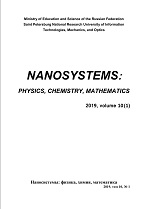|
This article is cited in 1 scientific paper (total in 1 paper)
CHEMISTRY AND MATERIAL SCIENCE
Review on NiO thin film as hole transport layer in perovskite solar cell
Kamal Bhujelab, Suman Raib, Ningthoujam Surajkumar Singha
a Physical Sciences Research Center, Pachhunga University College, Aizawl, 796001, India
b Laser and Photonics Laboratory, Department of Physics, Mizoram University, Aizawl, 796004, India
Abstract:
The saturation in increasing the power conversion efficiency (PCE) of silicon-based solar cells made researchers around world to look for the alternatives. An alternative solar cell would possess some basic requirements like cost effectiveness, reproducible, durable (stability), non-toxicity and higher efficiency. Perovskite solar cell (PSC) opened the new realm of hope for this alternative, consisting of perovskite absorber sandwich between the hole transport layer (HTL) and the electron transport layer (ETL). Good performance of PSCs can be achieved by optimizing many parameters of the components of PSC for obtaining the highest PCE. Among them, the HTL also plays a very vital role. Previously, organic poly (3,4-ethylene-dioxythiophene):poly (styrene sulfonic acid) PEDOT:PSS was being widely used as the HTL in PSCs, but due to its hygroscopic nature and acidic properties, it lowered the stability and the life time of the PSCs. Later it was replaced mostly by NiO, a p-type transparent conducting oxide (TCO) enhancing the PCE of PSCs. Its excellent stability and electrical/optical properties attracted the interest of many researchers. Different types of PSCs used NiO thin films prepared from different synthesis routes and obtained variation in efficiency of PSCs. Different parameters of NiO thin films like thickness, annealing temperature (AT) and duration, precursor combinations and more in synthesis processes, have a significant role in optimizing the PCE. Though there are many routes for obtaining NiO thin film, here we are trying to focus more on sol-gel method, as this route is very cost effective and employs basic equipment. Its evolution, present status and the future perspectives will also be discussed.
Keywords:
power conversion efficiency, organic photovoltaic device, annealing temperature, sol-gel method.
Received: 19.12.2020
Revised: 04.04.2021
Accepted: 03.12.2021
Citation:
Kamal Bhujel, Suman Rai, Ningthoujam Surajkumar Singh, “Review on NiO thin film as hole transport layer in perovskite solar cell”, Nanosystems: Physics, Chemistry, Mathematics, 12:6 (2021), 703–710
Linking options:
https://www.mathnet.ru/eng/nano1068 https://www.mathnet.ru/eng/nano/v12/i6/p703
|

| Statistics & downloads: |
| Abstract page: | 140 | | Full-text PDF : | 250 |
|




 Contact us:
Contact us: Terms of Use
Terms of Use
 Registration to the website
Registration to the website Logotypes
Logotypes








 Citation in format
Citation in format 
